Whether to ground your generator or not is probably the most misunderstood and debated topics when it comes to using a portable generator that new and even existing users have. I know when I first started using a generator, I was beyond confused. Everything was written in “electrician-speak” and people seemed to just be regurgitating an NEC or OSHA manual which was just as confusing for anyone new to the subject.
If you hang with me for just a little bit, I will do my absolute best to explain this topic as simply and “non-electrician” as possible to give you a solid understanding of what you need to do — or not do. I’m writing this in a particular order, so that things will make more sense as you continue reading.
If you’d like a more condensed version of this article, feel free to check out this accompanying article here on the only time you need to ground a portable generator. If anything needs further clarification, you can always return to this post which includes much more detail.
To summarize this article, I will submit a general statement and I will provide a chart with the conclusions of the article. However, don’t be overwhelmed by it yet. Once you finish the article, please re-read it and I assure you that it will all make sense.
As a general rule, a residential portable generator does not need to be grounded to the earth via a ground electrode or rod in any configuration unless it is supplying power to a house with a transfer switch that switches the neutral in the main panel. This makes the generator a separately derived system and requires a ground electrode per National Electric Code (NEC 250.30(A)). The generator must also be bonded in this case.
| Generator Type | Task | Should You Use It | Ground Rod Needed |
|---|---|---|---|
| Floating Neutral (Unbonded) | Extension Cords | Commonly used. Potential (though unlikely) shock hazard exists if a single fault were to occur. | No |
| Floating Neutral (Unbonded) | Power a House | Yes, will work with most transfer switches and interlock kits | No |
| Bonded Neutral | Extension Cords | Yes | No |
| Bonded Neutral | Power a House | Yes, ONLY with transfer switch that switches the neutral at the main panel – Generator becomes a “Separately Derived System” | Yes |
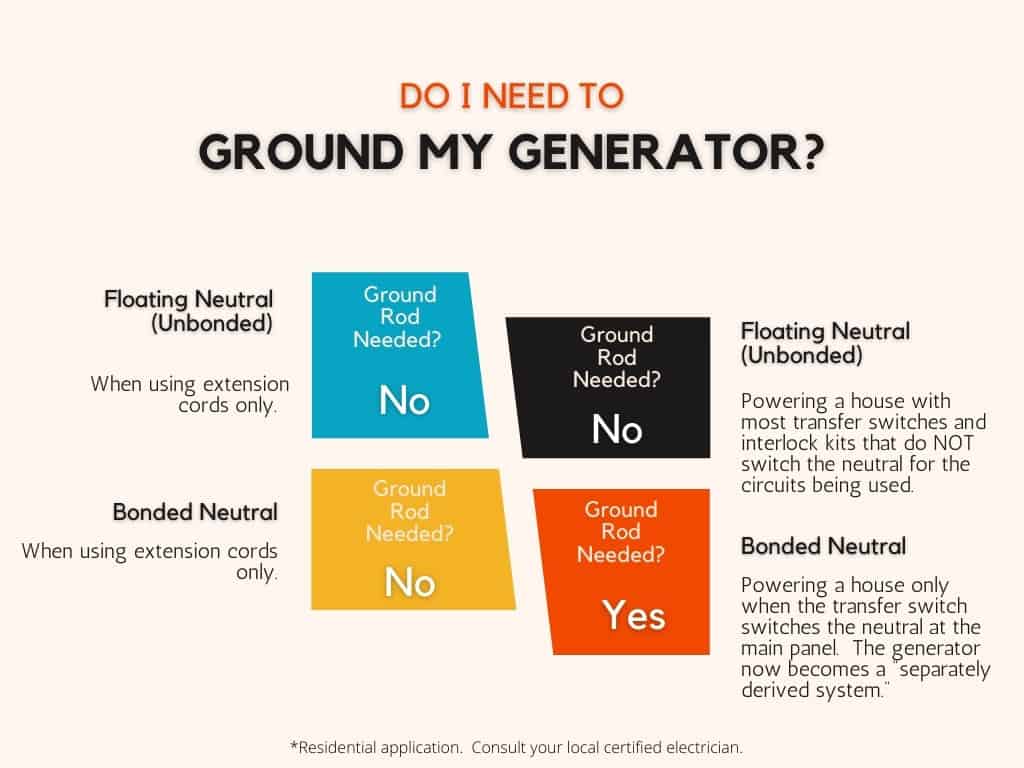
Alright, grab a quick cup of your favorite beverage and we’ll get into this. If you’re not familiar with electricity, I promise you’ll be fine! I must first discuss the purpose of “ground” and how electricity works in order to answer the question about whether or not your generator needs to be “grounded” and why you might be mistaking grounding for “bonding“.
***This article will deal primarily with portable household generators. All content in this article is for education purposes only and is not intended as actionable advice. Consult a certified electrician and follow all applicable laws, regulations, and codes in your jurisdiction. ***
What is the Purpose of Ground
In layman’s terms, the purpose of properly grounding your generator, or a home, is to help mitigate the damage caused by a lightning strike (indirect or direct) or a freak surge of electricity from the utility company and help direct it to the ground where it relieves some of the pressure on the wires of your system. Grounding to the earth is not a means to protect yourself electrocution from a fault in the circuit — that is bonding.
Before we continue, there’s one important thing to recognize. There are multiple way in which people use the term “ground”. I’m going to talk about ground rods/electrodes later in the article, but I’m going to also talk about “bonding”, which some people mistake for grounding.
If someone says, “does the generator need to be grounded?“, they could be asking if the generator needs to have a wire that leads to an 8′ copper rod in the ground (earth ground), or they could be asking if your appliances are grounded and will trip the breaker through the ground wire if there is a fault (bonding).
This article is going to focus heavily on bonding, but I will cover earth grounding with ground rods and electrodes later.
Here’s a video below that I made with a related topic about why a GFCI protected generator keeps tripping, just in case you’re also experiencing that issue.
Now, let’s get back to the main topic!
Basics on How AC Electricity works
Let’s go over a few overly-simplified basic points that you must know to understand how electricity works and I am NOT going to use electrician-speak! I’m assuming you’re new to this and these are just basic terms to start to grasp the concept and you can pick up the lingo as you go.
- For all intents and purposes, your main breaker box in your house (or a panel outside) is the “source” of your home’s power
- Electricity wants to flow in a closed circle (circuit) — from the source, to the appliance, and back to the source — NOT from the source, to the appliance, and to the earth
- If that circle is broken, the device being powered will not work
- If that circle is broken, the hot wire will be waiting to complete the circle in the easiest way possible (fully energized, but backed up — like a dam ready to break)
- If that circle is broken, we call that a “fault” or “short” (they are different, and there are different types within each category, but that’s for another day) — essentially we have electricity going where it’s not supposed to go, like if a wire came loose from its connection
- On a 120v system (normal wall outlet), the black wire (usually), or the little vertical slot on the right side of your receptacle, is “hot” and passes electricity to your appliance
- On a 120v system (normal wall outlet), the white wire (usually), or the longer vertical slot on the left side of your receptacle, is the “neutral” and brings the electricity back from the appliance, to the source, and completes the circle
- The small circular hole in the wall outlet is the green “ground” wire (usually, or bare copper), and is supposed to deliver current back to the source ONLY if there is a break in the circle
- If electricity is allowed to flow in a full circle WITHOUT going through an appliance and doing work (say you cut a lamp cord and touched the black and white wires together), then the breaker will “trip” and immediately stop the flow of electricity
- The purpose of equipment being “bonded” is so that YOU will be safe if you touch something with bad wiring — NOT necessarily that your electricity has a path back to the actual dirt outside your home
- The purpose of your house being “earth grounded” is to try to mitigate damage from lightning
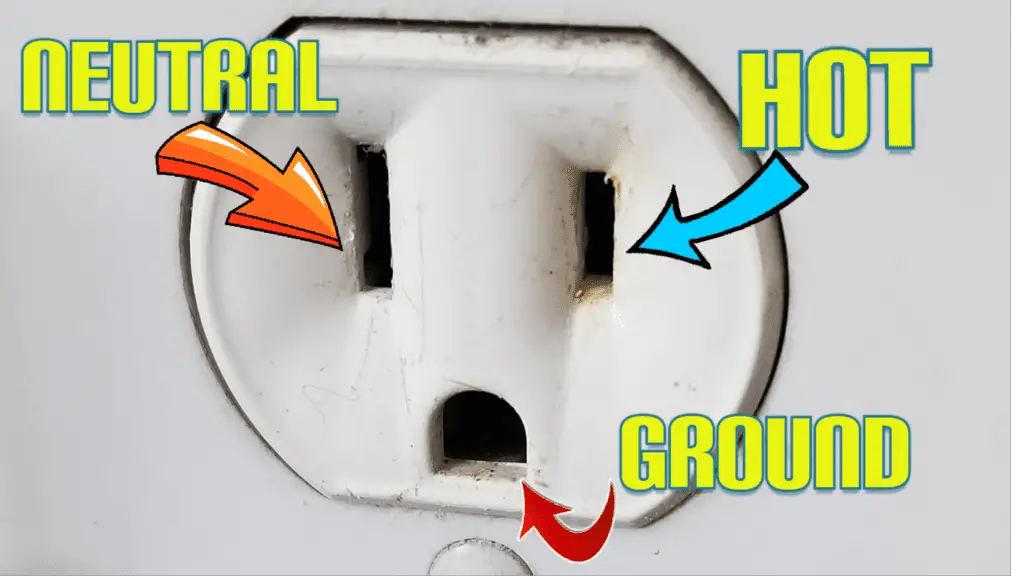
Let’s take an example to have this all make sense.
You plug in a toaster and go to operate it. The electricity flows from your main breaker box, through the hot wire, out the receptacle, through the cord of the toaster, does work by creating heat, and flows back through the neutral wires all the way back to your breaker box.
Simple, right? The circle was complete.
Now, let’s say the hot wire inside the toaster got disconnected and is now touching the metal frame of the toaster.
The circle is now incomplete. If this were not “grounded” properly (as in the ground wire not being attached to the frame), the hot wire would be supplying electricity to the frame of the toaster but it wouldn’t be doing anything yet. It would just be energized like a dam ready to break and waiting for something or someone to touch it so that it could try to complete the circle again.
If your toaster is “properly grounded”, then the frame of the toaster will be wired directly to the green wire on the toaster’s cord. That green wire runs from the toaster’s cord, through the outlet and the wires attached in the walls, all the way back to the source (your breaker box).
Here’s the cool thing: Inside of the breaker box, your neutral and ground wires are bonded together.

The circle is now complete, though it’s done through a different path, and the breaker will sense that the electricity is not doing any work and is simply flowing right back. The breaker will “trip”.
All of this should happen in a fraction of a second to save you from being electrocuted.
Then, when you go to use the toaster, it won’t work because the hot wire is still making contact with the frame. You’ll see that the breaker is tripped and the second you reset it it will trip again.
How a House is Grounded
Yes, a house has a metal rod(s) that run deep into the ground outside and yes, your breaker box connects to it. No, those rods aren’t there to save you from getting shocked if you have a wiring issue like with our problematic toaster.
Those rods are there to simply allow lightning, or any freak surge of energy from the power company, to go somewhere if it should hit near your house. Lightning does like to go to the earth, so ground rods make sense so that the lightning can get to the earth as easy as possible should it get caught in your house’s wiring through a direct or indirect hit. You’ll likely still have damage, but hopefully it won’t be as bad as it otherwise would have been.
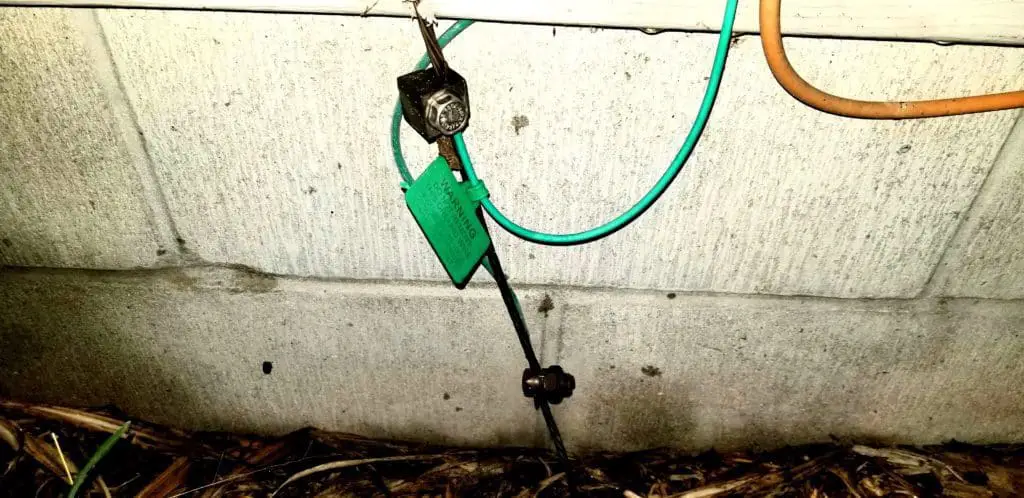
This is grounding with an electrode or ground rod, and we’ll talk about this later.
A house is bonded, for your safety, by having the neutral and the ground wire bonded together inside of the main breaker box. This provides an alternate route for rogue electricity to still have a path to complete the circuit, and to trip a breaker, should a wire become compromised.
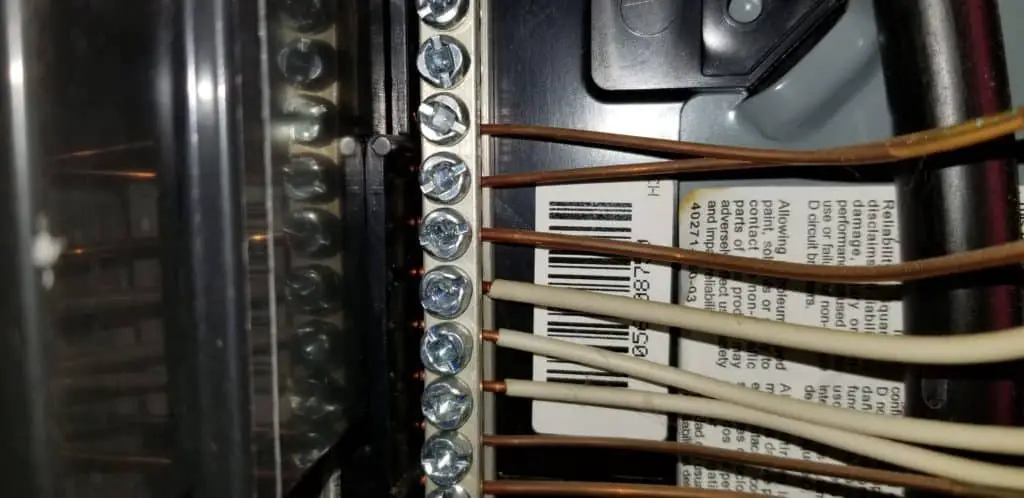
Remember from above that if the electricity cannot complete its path through the normal hot and neutral wires, it will travel through the ground wire which joins back up with the neutral wire in the breaker box to complete the circle. If the breaker senses that the electricity failed to do any work and is simply coming right back, it will shut off the power.
That is bonding. Nothing to do with running a rod into the earth, and everything to do with your immediate safety.
Ground rod is for lightning, bonding is for not getting shocked.
Still with me?
NOW, let’s move on to generators.
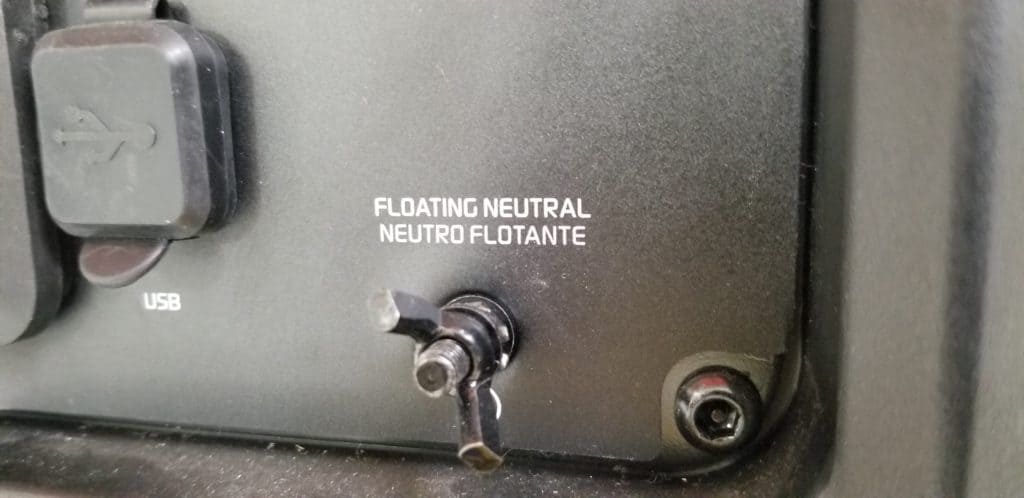
What’s the Difference Between a Bonded Neutral and a Floating Neutral Generator?
A bonded-neutral generator is one in which the neutral (return) is connected by a wire to the ground wire and the frame of the generator itself. This is typically done under the cap at the alternator end of the generator.
An unbonded generator, or floating neutral, is one in which the frame of the generator is in no way connected to the neutral (return) wires. The hot and neutral wires are on a completely different system than the ground wire and the frame.
Again, if you’re new to this, these words might as well be in a different language. Let’s make it make sense with an example.
If you have a floating neutral generator (neutral and ground are NOT connected in any way at the generator!) and plug a toaster into it, everything should work just fine if there are no issues with the wiring. Let’s say that there is that pesky loose hot wire from the example at the beginning.
The toaster frame is now energized but since the frame is connected to the green wire in the plug, it sends the electricity right back to the generator anyway to complete the circle, right?
Well, since the neutral and ground are NOT connected back at the source, there is no shock protection for you because the breaker on the generator will not trip because there is no circle. The electricity leaves through the black, returns on the green which is bonded to the frame of the generator. Since the green is not bonded with the white (the return path for the black), then you are essentially energizing the frame of your generator and the toaster as well.
With most 120v generators under 5kW (Page 5), this isn’t an issue as far as being a shock hazard because you still don’t complete the circuit (assuming it’s just a single fault in this case, and not another fault in the generator itself). Still, the fault won’t clear with a floating neutral generator and still poses a shock hazard if you were to somehow be messing with the item and the generator at the same time and found a way to complete the circuit.
On the other hand, if you had a bonded neutral generator and were to experience the same toaster issue, the toaster would send the current back through the same ground wire and when it arrived at the generator it would flow from the green ground wire to the place where it bonds with the neutral (usually under the alternator cap).
Once the green touches the white, the circle is complete, and the breaker on the generator will realize that no work is being performed and will immediately trip and stop the flow of electricity. Again, if things are properly set up, this will take a fraction of a second from start to finish.
Should I use a Bonded Neutral or a Floating Neutral as a Stand-Alone Generator (Plugging Extension Cords Directly Into the Generator Itself)
As we just saw above, if there is a problem with that toaster, then we are going to have overcurrent problems with a floating neutral generator since the breaker will not trip and the frame of the generator will remain a potential shock hazard if you were to find yourself completing the circuit somehow.
As a general rule, for maximum safety, only a bonded neutral generator should be used for stand-alone applications as it will trip a breaker and protect the user from a potential electrical shock if there is a ground fault.
In reality, hardly anyone cares.
Floating neutral generators are used all the time in home applications where extention cords are being used. If you experience the single fault with your toaster, then you’ll likely be just fine since the generator is isolated from the ground (since the ground and neutral are not bonded). The current cannot complete the circuit to shock you.
However, for example, if your extension cord’s insulation was damaged and a bit of the copper from the neutral wire was exposed and you touched it with your other hand while still holding the toaster, then you would complete the circuit.
Likewise, if the windings inside the generator made contact with the frame of the generator and you knelt down on some damp ground while holding the toaster, the current could flow through you, through the ground, up through the frame and back to the fault in the windings.
Again, we are trying to trip a breaker to protect ourselves, and that’s where bonding comes into play.
| Generator Type | Ideal Use |
|---|---|
| Bonded Neutral | For stand alone applications where you plug cords directly into the generator, or for feeding a home with a transfer switch that switches the neutral |
If you have a floating neutral generator and would like an easy fix to make it a bonded neutral generator, simply plug one of these nifty devices (Amazon) into your 120v outlets on your generator. You’ll have to sacrifice using one of your 120v outlets while it’s plugged in, but if you can make due with just using the other one then you’ll be fine.
You can also consult your generator’s manual or manufacturer to see if there is a way to bond them under the alternator’s cap or elsewhere on the generator.
Bonding a generator under the cap of the alternator or by using one of the devices above from Amazon will bond both your 120v and 240v lines.
Also, if your generator has GFCI receptacles, then you will be protected from faults and can safely use it for stand alone applications where you plug cords directly into the generator.
Should I use a Bonded Neutral Generator to Backfeed my House or a Floating Neutral?
You might be wondering why we would ever use a floating neutral generator if the frame is energized when there is a ground fault, like with our favorite toaster. At first glance, it seems that a grounded neutral has everything going for it!
Well, not so fast.
Generally, it is best to use a floating neutral (unbonded) generator to feed your home with most transfer switches or through a power inlet plug and an interlock kit, as these all share the same neutral. A bonded neutral generator should only be used with a transfer switch that switches the neutral at the main panel.
In fact, it may be illegal or certainly against code to use a generator that has a bonded neutral to backfeed your home with a transfer switch that does not switch the neutral.
| Generator Type | Ideal Use |
|---|---|
| Floating Neutral / Unbonded (Most Common) | For feeding a home with most transfer switches or through a power inlet plug and an interlock kit |
| Bonded Neutral | For feeding a home ONLY with a transfer switch that switches the neutral at the main panel |
When you backfeed power from your generator through a power inlet plug and use an interlock kit to stop the main breaker from being used at the same time as the breaker that you designated for your generator, the generator is essentially integrating itself into the homes existing wiring. The generator is sharing the two hots (each 120v), neutral, and ground with the 240-volt plug that connects to your panel.
Because of this, if there is a ground fault, like with our toaster, the toaster will send the rogue electricity back through the ground wire, to the main panel, it will bond with the neutral wire at the panel itself, and the neutral wire will carry the electricity that hasn’t performed any work back to the generator where it will finally trip the breaker.
If you had a bonded neutral generator hooked up to a bonded neutral home, then you have just created a system in which electricity can take parallel paths and this may be dangerous depending on the situation.
When I said “parallel paths”, you probably called me out for speaking electrician.
Let me explain, and I have some Picasso worthy drawings below to follow along.
Let’s say you have bonded neutral generator that’s feeding power through a power inlet plug with an interlock kit (or most transfer switches). That power goes to your breaker box and you decide to use, oh, I don’t know, your trusty toaster again. You enable that breaker for the toaster and go to power it.
Like before, the hot wire came loose and is touching the frame inside the toaster. Not a problem so far since the frame is connected to the green ground wire and it sends the rogue electricity back to the panel along the green wire only. At the panel it meets up with the white wire (the return wire) since the ground and neutral are bonded at your home’s breaker box.
However, since the bonded neutral generator ALSO has its ground wire and neutral wires bonded, the electricity can now flow back from the panel to the generator along BOTH the neutral and the ground wire (parallel). In other words, the ground and the neutral connect at the generator and they both connect again in the main panel. This essentially makes them function as the same wire.
Those two wires touch on both ends, making their own circle within the larger circle that involves the hot wire as well.
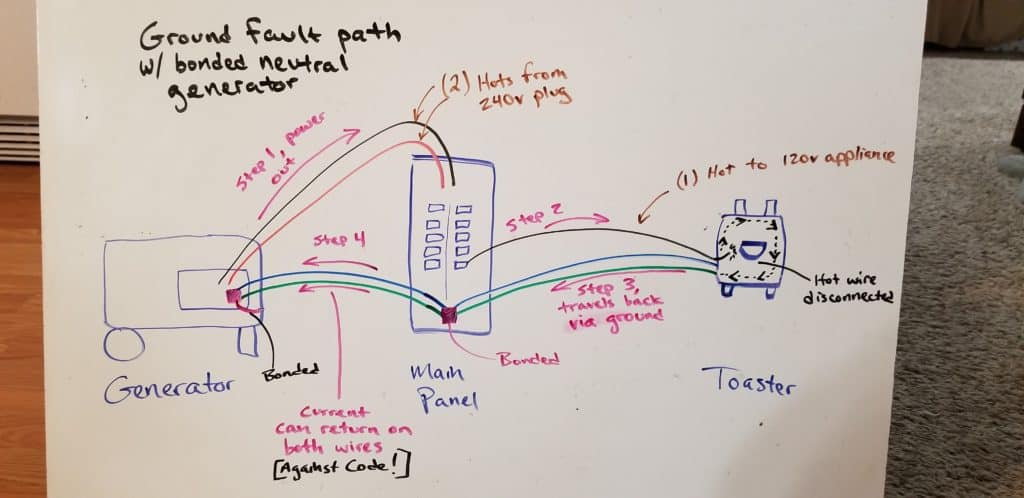
In fact, this parallel path will exist even if your toaster doesn’t have a problem and works perfectly. In that case, the current will leave the generator, go to the breaker box, power the toaster, return on the neutral wire back to the breaker box where it will also touch the ground, and since the ground and the neutral wires connect at both the breaker box and the generator, the electricity will take both wires back to the source.
With a floating neutral generator and the same situation listed above, the rogue electricity would leave the toaster through the green ground wire, hit the house’s main panel and join up with the neutral wire. Since the neutral wire is not connected with the ground wire at the generator, the only path back to the source (your generator) is through the neutral wire.
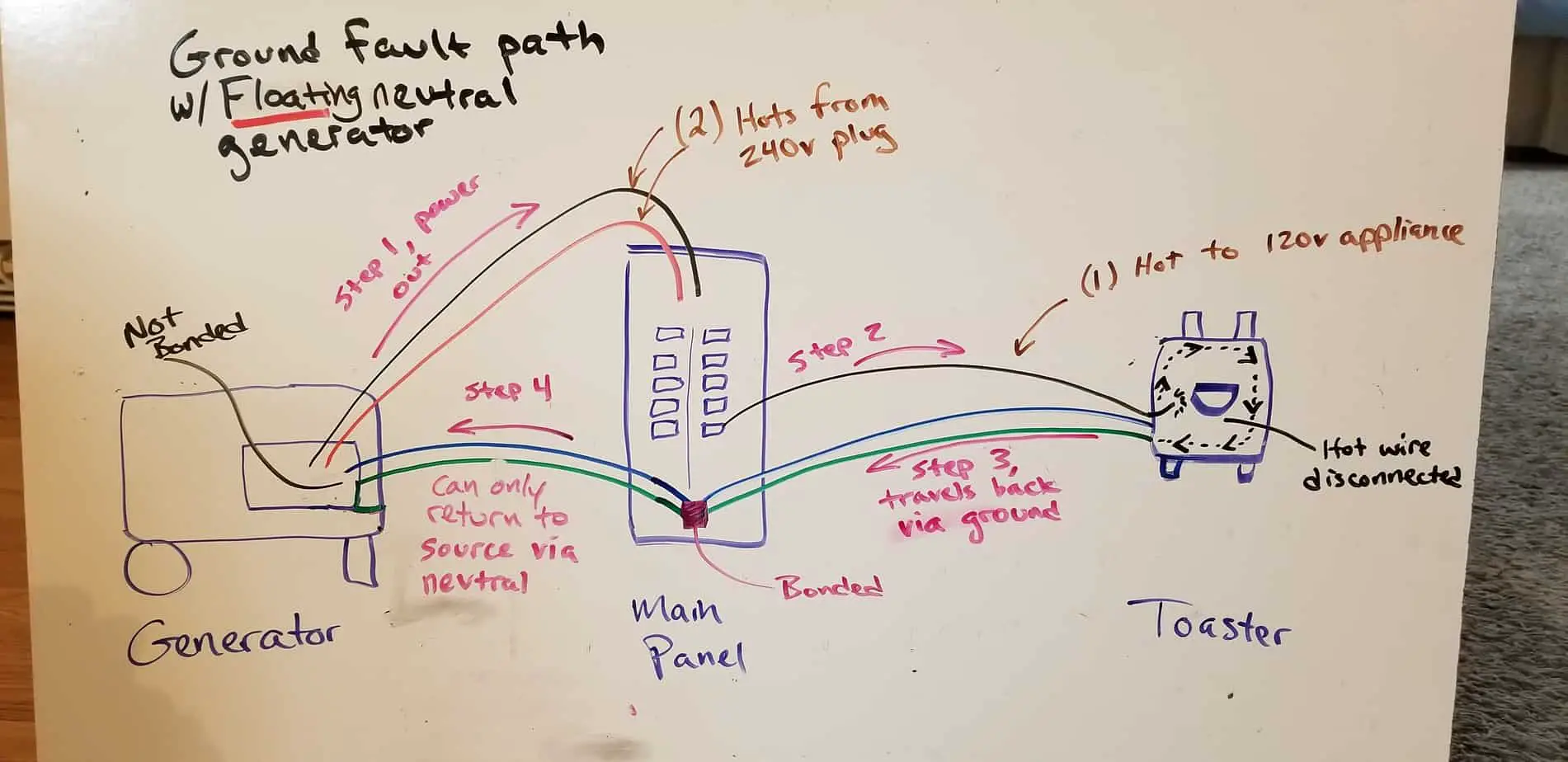
I hope that made sense!
I’ve not had this problem myself, but from my research is has been said that if you have parallel paths like that and you run too high of a load, the ground wire is sometimes not as thick as the hot and the neutral and isn’t designed to carry a full current full time. It’s only designed to carry current in a fault situation and trip the breaker. If the wire is too small for the load, you could melt the wire or start a fire.
Either way, regardless of how dangerous it is, it is against NEC code. The ground wire is not meant to carry current if there isn’t a fault.
Most transfer switches (unless yours specifies otherwise) keep the neutral and ground intact with the generator when you connect it up and only switch over the hot connections. This means that you will need to use a floating neutral generator to keep from having parallel paths of travel for the return current back to the generator.
If your generator is a bonded neutral generator and you had your transfer switch professionally installed, then they probably already set you up with a switch that breaks the neutral connection with the house and only uses the neutral and ground from the generator (while switching the hots as well).
If you do not know what your particular transfer switch does or what generator you should use with it, then it is best to contact a qualified electrician.
How to Tell if a Generator is Bonded Neutral or Floating Neutral/(Unbonded)
This can easily be done by using even the cheapest of multimeters and simply setting the dial to continuity. That’s the setting where it will beep if you touch the two leads together and signals to the multimeter that current is able to pass through something without being obstructed.
With the generator off, simply place one lead (probe) into the longer, vertical slit on the left side of one of your generator’s outlets (this is the neutral), and then place the other lead (probe) onto the ground stud which should be on your panel.
If it beeps, you have a bonded neutral generator. If it doesn’t beep, you have a floating neutral generator.

What to Do if My Generator is Bonded Neutral and Needs to be Floating Neutral (Unbonded) or Vice Versa
It is best to consult with your generator’s particular manual to determine the best course of action, or you may even find it on Youtube. Some generator companies, like Champion, actually show you how.
Often, you can simply remove the cap from the alternator end of the generator and you will see a wire that runs from the ground stud on the frame to the neutral wire. This can simply be removed.
Not all generators are that way, so you’ll have to take things on an individual basis.
If you want to bond the neutral when you have a floating neutral, consult with the manual first. If you do add a jumper between the ground and the neutral under the cap of your alternator, be sure to use the correct gauge of wire.

Either way, ALWAYS make sure you place a prominent label on your generator to remind you (or anyone else) what has been done to it regarding the ground and neutral.
You can always use one of these devices (Amazon) that I recommended above and you’ll be able to quickly turn your generator into a bonded neutral from a floating neutral. Simply plug, and unplug as needed.
Do I need a Ground Rod or Electrode for my Generator?
I had the hardest time finding the answer to this question and I’m sure you did too. After HOURS and HOURS of research, this is what I was able to gather and I truly hope it helps. I will start off with my disclaimers:
- Though I have years of generator use and repair experience along with a background in facilities maintenance, I am not a certified electrician and this is not advice to be acted upon without consulting a certified electrician
- Follow the instructions of your generator’s manual
- Follow all applicable laws, regulations, and codes for your jurisdiction
Generally, the only time in which a residential portable generator needs to have a ground electrode (ground rod) is when it is a bonded-neutral system and backfeeding a house through a transfer switch that switches the neutral at the main panel. This makes it a separately derived system and NEC code requires it to be grounded to the earth by means of an electrode.
| Situation | Electrode Needed | Notes |
|---|---|---|
| Stand-alone unbonded generator (floating neutral), plugging items in to outlets directly, frame has contact with the ground or is bonded to vehicle frame, and all non-current carrying metal components are grounded to the frame | No | Generator frame serves as the “earth ground” connection. Despite the commonly held belief, a floating neutral generator WILL NOT trip the breaker and protect you from shock by simply attaching it to a ground rod — the generator must be bonded for potential (unlikely) shock protection |
| Stand-alone bonded neutral generator, plugging items in to outlets directly, frame has contact with the ground or is bonded to vehicle frame, and all non-current carrying metal components are grounded to the frame | No | Generator frame serves as the “earth ground” connection |
| Transfer switch that keeps neutral and ground system intact or a interlock kit (used with a floating neutral generator) | No | Not a separately-derived system since the neutral hasn’t been switched (Generator is technically using the ground electrode from the home since shares the neutral and ground connections) |
| Transfer switch that switches the neutral (used with a bonded-neutral generator) | Yes | Separately derived system, no longer shares the ground rod connection of the house, grounding electrode needed at the generator itself |
For Hooking up to a House, see the following video from 3:20 – 7:00. Keep in mind that a generator is only considered to be a “separately derived system” when the grounded (neutral) conductor in the transfer switch is switched (it no longer shares the neutral or ground with the main panel).
Most transfer switches keep the neutral and ground connections intact with those from the generator, but some will actually switch the neutral from whatever breaker you are using and tie it to the generator itself. This severs that breaker from having a connection with the ground and neutral bond at the main panel (and thus, the home’s ground rod is now out of the equation). In this case, you’d want a bonded neutral generator and it would require a grounding electrode (ground rod) since the generator and the breakers tied to it are on a separately derived system.
You can check out this write up here by John “Grizzy” Grzywacz (Certified Electrical Inspector, former OSHA Training Director). In it, he covers OSHA’s 1926.404(f)(3)(i) where it covers when a generator frame serves as the ground electrode.
In it, it basically says that as long as your generator is only being used to plug things into the receptacles, AND as long as the GROUND pins of the receptacles are tied to the frame, AND the non-current carrying parts of your generator are bonded to the frame as well (gas tank, etc.), then you do NOT need a ground rod or electrode. He also covers why using a ground rod when it is not required can cause an electrocution hazard.
Both floating-neutral and bonded-neutral generators meet the criteria in the paragraph above, as it ONLY refers to GROUND pins from the receptacles and NOT the NEUTRAL pins. Whether it’s bonded or unbonded isn’t part of the code. The stipulations also assume that you didn’t modify your generator regarding the grounding conductors on the frame (remove the bond between the gas tank and the frame, for instance).
As I mentioned above, if you have a bonded neutral generator, you’re safe when it comes to plugging appliances directly into the generator’s outlets (not backfeeding your home). If there is a fault, the breaker will trip. You are safe in this instance and for all intents and purposes. Your generator’s frame serves as the ground electrode for lightning. No ground electrode or rod is required, and may actually serve as a hazard if you use one.
However, for covering my rear end, I will always say to follow your owner’s manual, codes, etc. In our litigious society, you can’t blame them as well for including extra things that might not even be necessary in order to cover their rear ends either. However, recommending an auxiliary grounding rod (optional, not needed) can be dangerous. See the video above or the link in the previous paragraph. Please check for an updated manual online for your generator.
Now, if you have a floating neutral where the neutral and the ground never meet and the generator frame can become energized, you might certainly jump to the conclusion that a wire leading from the ground terminal connection on the side of the generator to a copper rod in the ground would send all of that rogue electricity back to the earth.
I believed that for a while as well. In reality, it’s just not the case. The frame stays energized and the rod too, but the electricity is still just backed up with nowhere to go and no circle to complete. Because of this, the breaker never trips and the ground rod doesn’t really make things any safer for you to touch. Again, grounding and bonding are two separate issues.
Yes, you can still get shocked from a floating neutral with a fault. Regardless, the frame of the generator serves as the ground electrode for lightning purposes and a ground rod is NOT needed. Again, two separate issues.
I HIGHLY recommend watching this entire video, but you can skip to 10:30 to watch what I’m talking about above.
Like I said before, follow your owner’s manual and NEC/OSHA requirements and consult your local certified electrician. I am not your certified electrician.
Also, if you have time, this video will rock your world when it comes to myths regarding “Ground”. It’s well worth a watch!!!
To Summarize Everything
| Generator Type | Task | Should You Use It | Ground Rod Needed |
|---|---|---|---|
| Floating Neutral (Unbonded) | Extension Cords | Not Recommended | No |
| Floating Neutral (Unbonded) | Power a House | Yes, will work with most transfer switches and interlock kits | No |
| Bonded Neutral | Extension Cords | Yes | No |
| Bonded Neutral | Power a House | Yes, ONLY with transfer switch that switches the neutral at the main panel | Yes |
Hopefully this was relatively easy to understand for someone with limited or no knowledge of electricity. That was the purpose of this article and hopefully it should get you pointed in the right direction to do more of your own research if you still have questions.
Of course, if you have specific questions for your specific situation, I recommend contacting your local certified electrician.
With that being said, remember that if you are going to simply be plugging in extension cords or power tools to your generator that you should ideally use a BONDED NEUTRAL generator to keep yourself safe from electrocution or death. A bonded neutral generator ensures that a fault has a return path back to the generator and that it will trip the breaker if there is an issue and keep you safe.
If you insist on using a floating neutral to plug things into, please use caution in wet and damp environments, since that’s when you’ll be in the greatest danger.
If you are going to be backfeeding a house with your generator (with a properly and professionally installed interlock kit / transfer switch), you will only want to use a floating neutral generator since there can only be one bonded neutral point and that point exists already in your breaker box. Only use a bonded-neutral generator if the transfer switch switches the neutral at the main panel, and you must also use a ground electrode in that case.
